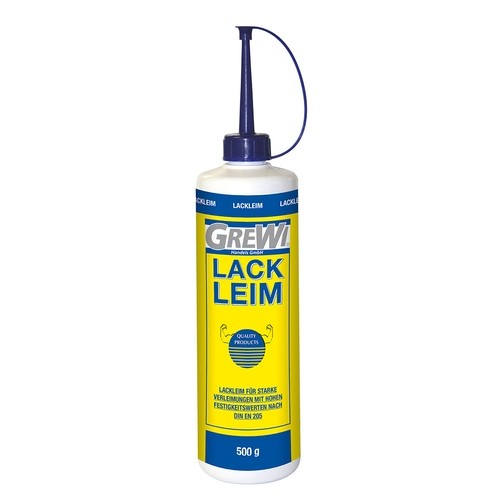
- Artikel-Nr.: ART5249HPH
GREWI Lackleim 500 is a one-component glue developed for strong bonding with high strength values according to DIN EN 205.
Fields of application:
Gluing of trim, wood and wood-based materials to DD lacquers, polyester surfaces, SH lacquers, water-based lacquers, nitro lacquers, melamine resin surfaces and DKS surfaces.
Carcass gluing with melamine resin coated and lacquered surfaces.
Properties:
One-component glue
Excellent adhesion without sanding
Strength values above 10 N/mm² according to DIN EN 205
Can be processed in a glue pressure tank
Good moisture resistance
Tough-elastic, tool-friendly glue film
Density at 20°C: approx. 1.0 g/cm³
pH value: 8.5 ± 0.5
Color of glue: beige
Consistency: medium viscosity
Viscosity at 20°C - Brookfield RVT Sp. 6/20 Upm: 13,000 ± 2,500 mPa. s
Open time at 20°C: 6 - 8 minutes
White point: approx. +5°C
Not subject to labeling according to EU regulations (See our safety data sheet).
Processing:
The material to be glued must be absorbent, free of dust, oil, grease and dry.
The most favorable processing temperature is 18 - 20°C. Neither material nor glue may be processed below +10°C.
In general, glue application on one side is sufficient. For hard and exotic woods, glue application on both sides is recommended.
Application quantity: approx. 150 g/m²
The open time is influenced by the application quantity, absorbency of the materials, wood and air humidity and temperature.
Pressing time: For wood/wood joints from 15 minutes. Preheating on one side accelerates the setting process. Apply pressure of at least 0.2 N/mm².
Clean tools and machines with warm water.
Important note:
In view of the large number of varnishes and plastics, own tests of adhesion properties and resistance on the materials to be glued are recommended.
Wood and wood-based materials are natural substances. Due to the different composition of wood ingredients (caused by growth area, pre-treatment), color changes may occur in individual cases (e.g. beech, cherry, sugar maple). Furthermore, bonding of woods containing tannins (e.g. oak) and contact with iron (e.g. unsuitable pressing equipment) may also result in color changes.




